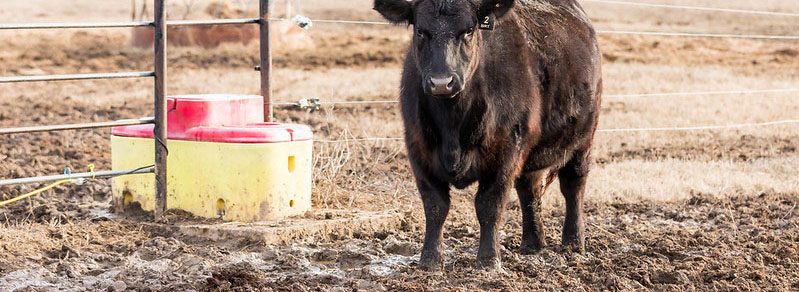
The environment in which cattle are living, including mud, can lead to hoof issues, say K-State veterinarians. | Download this photo
Cattle Chat: Time for a trim?
K-State veterinarians discuss factors influencing the pace of hoof growth
At a glance: K-State Beef Cattle Institute veterinarians explain how the age of the cow, genetics and diet influence hoof growth.
Photo: https://www.flickr.com/photos/ksrecomm/53514403587
Feb. 20, 2024
By Lisa Moser, K-State Research and Extension news service
MANHATTAN, Kan. — Just as people cut their toenails when they get too long, some beef cattle also need to have their hooves trimmed on occasion to help keep them from going lame, say Kansas State University veterinarians at the Beef Cattle Institute.
Talking on a recent Cattle Chat podcast, the veterinarians answered a listener's question about reasons that the animals in the herd require hoof trims regularly.
“In beef cattle operations, cows walking around on the ground, rocks and sand, typically have normal wear that keeps their hooves the length they need to be,” said K-State veterinarian Brian Lubbers. “However, sometimes older cows that don’t move around much will need to have their hooves trimmed.”
Lubbers said if just a few cows out of 100 need hoof trims, that is considered to be normal.
“If 2% of the herd needs a routine trim, that is to be expected. But if 50% of the herd needs to have their hooves trimmed yearly, then there is likely something else going on,” Lubbers said.
One reason for the excess hoof growth may relate to the cow’s diet, said K-State veterinarian Bob Larson.
“Cattle eating a high grain diet or ones that are consuming crop residues with substantial amounts of grain can get acidosis, which can lead to hoof problems,” Larson said. “Also, there are some minerals that need to be included in the diet to promote healthy hoof growth.”
In addition, genetics can play a role in hoof growth, added K-State veterinarian Brad White.
“There is a genetic component to corkscrew claw, which is a claw that turns under the hoof, and those will have to be trimmed regularly,” White said.
The environment can also lead to hoof issues, said the veterinarians. For example, they said cattle standing in mud can experience foot rot. Also, if they happen to step on a sharp object, the cattle can develop an abscess in the soft tissue attached to the hoof.
“Any time the cattle are experiencing a hoof issue, it is really important to get them in a place where the veterinarian can do a thorough examination to determine the problem and treat it appropriately,” Larson said.
To hear the full discussion, listen to Cattle Chat on your preferred streaming platform.
***

K‑State Research and Extension is a short name for the Kansas State University Agricultural Experiment Station and Cooperative Extension Service, a program designed to generate and distribute useful knowledge for the well‑being of Kansans. Supported by county, state, federal and private funds, the program has county extension offices, experiment fields, area extension offices and regional research centers statewide. Its headquarters is on the K‑State campus in Manhattan. For more information, visit www.ksre.ksu.edu. K-State Research and Extension is an equal opportunity provider and employer.